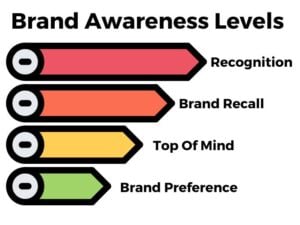When you are buying toys, do you look for plastic blocks or Legos? When you are shopping for office supplies, do you search for sticky paper or Post-It Notes?
These brands have successfully embedded their product names in their respective industries. They have become so well-known that people would mention these brands’ names rather than their generic terms (Kleenex vs. tissue, Coke vs. cola, Band-Aid vs. bandage, and so on).
And that’s the magic of building brand awareness.
In this guide, we will discuss the importance of brand awareness for your business gaining customer loyalty.
Find out why you should prioritize brand awareness in your digital marketing campaigns, and discover what marketing strategies you can use to establish your brand among your audience.
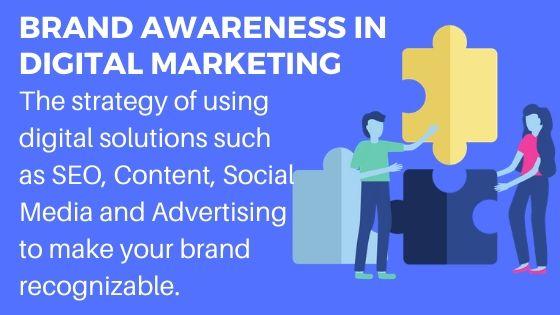
What Is Brand Awareness in Digital Marketing?
Brand awareness is a term that refers to the degree of consumer familiarity of a product by its name using various marketing channels.
It distinguishes the product of a brand from its competition.
Simply put, it is a measure of how well your target audience recognizes your brand.
And what does a high level of brand awareness mean for your business?
More sales.
When consumers are confronted with choices, they are more likely to buy a product from a brand they are most familiar with.
That’s why brand awareness should be a priority for businesses, especially startup brands.
In fact, brand awareness is so crucial that 37% of marketers say it was their top priority in 2019.
Now that you get how vital brand awareness is to you, the next question is: “How can you create brand awareness?”
One way to do this is through correctly utilizing the many digital marketing channels at your disposal.
How Digital Marketing Can Increase Brand Awareness
Over the years, digital marketing has become a gamechanger for many brands.
It is continuously dominating many marketing channels, with over half of the world’s population using the Internet.
With digital marketing, you can:
- Reach a more targeted audience in a more cost-effective and measurable way
- Level the playing field, especially if you’re a small business
- Interact with prospects and learn valuable insights from them
- Be hyper-personalized with your audience
- Reach a new audience/ global marketplace
Online is where your customers are. And using digital marketing channels is beneficial to reach them, hence establishing awareness around your brand.
To get started with digital marketing, here are some strategies you can do to increase consumer familiarity with your product.
Digital Strategies to Increase Brand Awareness
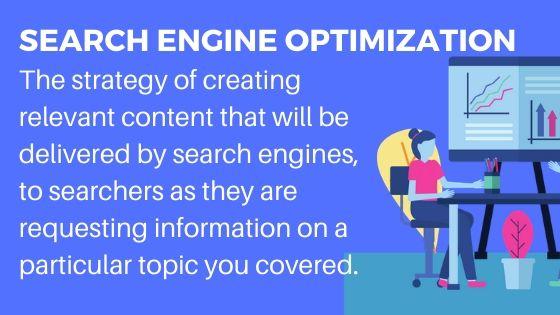
Search Engine Optimization
You want your brand to be found online and beat the competition. And this is what search engine optimization (SEO) can accomplish for you.
SEO helps show your product in front of your customers. This strategy allows your webpage to appear on the first page of search results, such as Google.
The primary role of SEO is to gain websites ‘unpaid’ organic site traffic from the search engine results page (SERPs).
This is done through various on-page and off-page methods.
How SEO Impacts Brand Awareness
With increased traffic to your website, your brand gets exposed to a broader audience.
And more exposure means more people recognize what your brand does.
For instance, one case study illustrates how digital marketing consultant Hunter Branch saw firsthand what SEO could do to improve brand awareness.
Brand Awareness Example Using SEO
In the said study, Branch shared working with one client, a writing coach, who was generating about 20,000 visitors monthly from search.
The client is already a successful author prior to putting up his online presence.
After implementing a full-blown SEO strategy, the client, who just transitioned to becoming an online writing coach, started to gain an average of 140,000 organic visitors per month.
But here’s the best part: The client is now widely known as one of the top writing coaches online.
That’s how appearing in the top 3 organic search results made an impact on his branding.
How to Boost Brand Awareness with SEO
As of this year, more than 64% of marketers are actively investing in SEO.
You should want to keep up with the competition, here are some ways to use SEO for brand building.
Link building
The more quality links that refer to your page, the higher you rank in the SERPs. But how do you get those links?
I believe that valuable content is equal to strong backlinks.
By content, I mean unique, relevant, and valuable content made for users & for search engines.
Some examples include how-to guides and free downloadable templates.
Aside from creating content, you can also build backlinks through email outreach, guest posting, and public relations, among others.
Optimizing content
Creating content is one thing; optimizing content is another.
For Google to find your content, you have to add keywords to your page to increase organic visibility.
Since you’re specifically targeting audiences at the awareness stage, it is also essential to optimize your content for non-commercial keywords.
Another key is to put more focus on long-tail keywords. This type of keywords has a 3% to 5% higher click rate than generic searches.
Also, aligning your keyword strategy with your branding helps you assert more control over the perception of your brand.
That’s why it is crucial to choose keywords that are relevant to your brand.
Internal Linking
When a prospect landed on your page, help him navigate around your website through internal linking.
Internal linking involves adding a link to another page on your site using anchor text.
Anchor text can be your main keywords, a variation of your main keywords, or secondary long-tail keywords.
With a clear strategy, you can improve the user experience while driving more site traffic to your pages.
But internal linking does not only direct visitors to your other pages. It also passes link equity to improve your SERPs ranking.
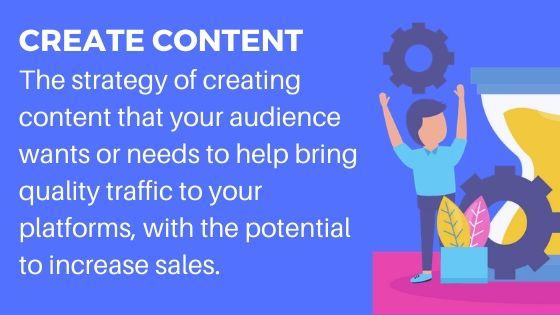
Content Creation
In the previous strategy, we have briefly touched the importance of content.
However, since content creation is so vital in brand building, it warrants further discussion as our next digital strategy.
For this guide, we’ll focus on the creation of branded content and how it impacts your brand awareness campaigns.
But what is branded content?
Branded content is content that brings value to your new customers.
It lets you show to your audience who your company is and what your brand represents.
This type of content strays from traditional advertising. Its purpose is to entertain or to inform, to catch consumer’s attention, and drive real engagement.
This includes articles, videos, infographics, and podcasts, among others.
How Content Creation Impacts Brand Awareness
Creating brand awareness marketing campaigns is more than just consumers knowing your brand name. It shows how well your audience understands the qualities that make your company unique.
It is through developing an effective content strategy that sets your brand apart from the competition.
Content is also a way to show personality, share opinions, and to position your brand on issues. Simply put, content is what humanizes your brand.
And consumers would likely do business with humans over a mere brand.
Brand Awareness Example Using Content Creation
One great example of a successful branded content is Dove’s Real Beauty Sketches campaign.
The campaign started with customer research suggesting that only 4% of women would describe themselves as “beautiful.”
From the said research, Dove came up with a short video highlighting how women perceive themselves versus how strangers describe them.
The video garnered over 114 million views in just one month, and it became the most-watched branded content in 2013, even with some intense criticisms of the ad.
With the campaign’s success, Dove got the world talking. And the best part? Dove was able to send their brand message that “beauty is for everyone,” separating them from their competitors.
How to Boost Brand Awareness with Content
According to B2B Content Marketing, seventy-two percent of marketers believe having a good content strategy was a significant key to their success.
Do you implement a content strategy for your brand already?
If not, here are some ways to get you started.
Understand your audience
Who is your audience? Where do they spend their time online? What are their likes, preferences, and interests? What are their problems that needed solutions?
You are connecting with your audience, so naturally, you will begin to understand them.
And when you have a good understanding of your audience, you can tailor your content to make it speak to them.
Create your brand story
Aside from your audience, you should also understand your brand.
What is your story? What are your visions? What are your company’s values? What is your company’s voice? What solution do you offer to your audience?
To craft an effective content strategy, you must know these crucial things about your business because these are the reasons why your new customers would care about your brand.
Choose your digital marketing channels
Which type of content do you want to use for your brand? For the awareness stage, you’ve got plenty to choose from.
Blog posts and articles are the most common forms of content for the early stage in the marketing funnel.
If you’re looking for content ideas, this is where your understanding of your audience would come in handy.
If you’re targeting an audience with a short attention span, infographics are a perfect choice. This is because this type of content is easy to read and understand.
Meanwhile, videos are a great avenue to show the personalities of your brand. Statistics also show that video is the number one form of media used in content strategy, overtaking the first two forms of content mentioned above.
Videos are thus a sure-shot way of increasing engagement from your target audience. You can use a video maker to create short or long-form videos depending upon the type of platform you want to post your branded videos.
Test your content strategy
Now that you have determined vital elements of a good content strategy, it’s time to put them together and create your content.
Monitor how your content performs, analyze its effectiveness through key metrics, and adjust as needed.
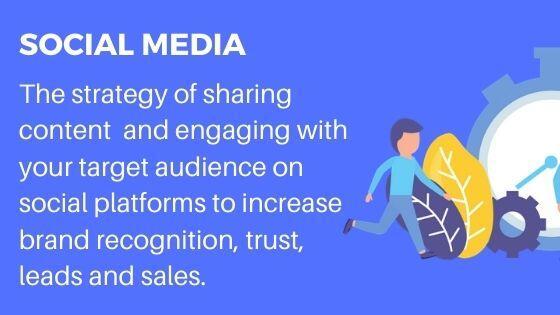
Social Media
What’s a better place to be in as a brand than with social media?
These platforms have billions of social media users waiting to become your customer. Also, it’s free to create your accounts on social media. And if you’re running ads, you can achieve a lot with a meager budget.
With the number of opportunities available using social media marketing, you don’t want to miss out on this essential marketing strategy.
So, whether it’s on Facebook, Instagram, YouTube, LinkedIn, or other channels, it is crucial to establish your presence using social media marketing to boost brand awareness.
How Social Media Impacts Brand Awareness
Your audience spends a lot of their time browsing through their feeds.
On average, internet users spend 144 minutes per day using social media according to Statista.
This presents a great opportunity for your business to reach them online.
Having a social media presence helps you become more visible to your customers.
It allows you to connect with them, engage with them, more importantly, increase brand recognition, and create brand advocates.
By sharing your brand voice and story on social, whether through posting compelling content or running ads, you can raise awareness of your business.
Brand Awareness Example Using Social Media
Not everyone would be interested in a blender.
However, many would like watching random objects be smashed into a pulp for some reason.
Blendtec’s “Will it blend campaign” just tapped into this unexpected interest.
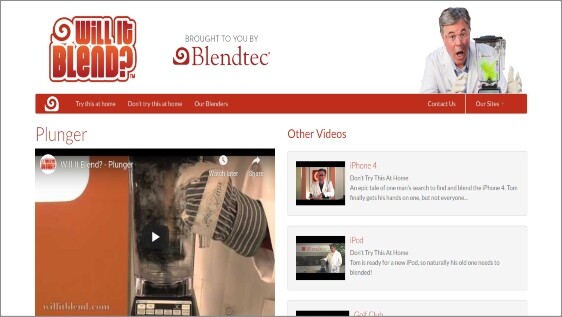
In a Facebook video campaign, Blendtec tried to blend some of the most random objects while asking the question, “Will it blend?”
The brand was able to pique the curiosity of its audience that resulted in thousands of views. It also inspired multiple spin-offs of other brands trying similar tests.
The takeaway: be creative in showing off the power of your product with your social media marketing strategies.
Even a product can provide entertainment to your audience while showcasing its abilities.
How to Boost Brand Awareness with Social Media
If you’re still not taking advantage of social media advertising, you’re missing a lot.
Whether you’re new to social media marketing or are already using it, you need to have a deep understanding of your brand and your audience to catch up with your competitors.
Then, here’s what you need to do next with your social media campaign.
Set SMART goals
You have to be clear on your goals when using social media marketing, and the SMART goal framework helps you with that.
The SMART framework requires you to have goals that are:
- Specific
- Measurable
- Attainable
- Relevant
- Time-bound
Here’s an example of a SMART goal:
“We will increase brand awareness by increasing the number of impressions to 10,000 by the end of the fourth quarter.”
Determine key metrics
Having a SMART goal also helps you establish key metrics to measure the performance of your strategy.
You can track different social media metrics depending on your campaign. What’s important is to determine which metrics are relevant to you. For high brand awareness, metrics like reach, impressions, shares, and mentions can tell a lot about your progress.
Choose your platform
Each social media platform is unique. To succeed in your effort, you have to determine which platforms best fit your goals and strategy.
You don’t have to be on every platform. Pick the one that is relevant to your brand and your audience.
Determine where your potential customers hang out. For instance, if you’re a makeup brand, you would benefit more in visual platforms like Snapchat and Instagram.
Once you have picked the platform, fill out your profiles completely, including profile and cover photos, bio, and profile info. Also, include keywords that people would use to search for your business.
Leverage other people’s audience
Influencer marketing is an amazing way to build brand awareness to a qualified audience.
Being able to leverage someone who has a household name, even if it’s just industry-focused, can propel your social media engagement in much less time.
In the early stages of your social journey, it will take a lot of effort for your social media posts to be effective in building awareness around your brand.
Leverage other’s who have a matching target audience to establish trust, get more sales, and help with your short-term marketing goals.
Create a social media content calendar
Next, determine what you should be posting, how often should you post, and when is the best time to post content.
Having a social media content calendar helps make your posting organized.
You can use it to plan all of your social media marketing efforts across all your channels.
When creating your social media calendar, remember to have a mix of content you created and curated from other sources.
Then, experiment on which type of content works for you: links, videos, images, quotes, reshares, and plain text updates.
For starters, you may adopt the 80-20 rule, which states that 80% of your posts should inform, educate, or entertain.
The other 20% can be content that directly promotes your brand.
Test and Analyze
As you begin posting content, you’ll find out which content, schedule, and frequency performs best for your business.
Using social media analytics tool like Buffer helps you test and analyze each post.
Using the insights you have obtained, test different posts, campaigns, and marketing strategies against each other.
Once you determine what works best, it’s time to adjust your strategy.
Focus more on the proven methods that work and refine them so you get the most out of your brand awareness campaign.
Engage
Finally, don’t forget the social aspect of social media marketing. Engage with your community.
Reply to comments, look for mentions, follow conversations, and monitor feedback about your brand, products, and services.
Allot time in your day to engage with your audience.
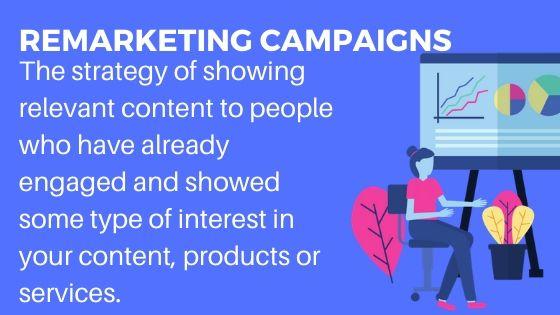
Remarketing Campaigns
Remarketing is a type of online advertising that allows you to show targeted ads to people who have already visited your website.
This ad follows visitors across the Internet. They appear as they browse the web, watch YouTube videos, and scroll through their social media feeds.
How Remarketing Impacts Brand Awareness
Remarketing allows you to remain connected with your audience. Once people visit your website, ads will follow them all over the web.
This gives your brand great exposure. And more exposure means your brand becomes more recognizable, giving you a competitive advantage.
But aside from brand awareness, remarketing campaigns also increase the chance of your visitors taking action.
This is especially crucial since 70% to 96% of websites visitors leave without taking action and will never return, according to Bounce Exchange.
Brand Awareness Example Using Remarketing
Software company Lumension achieved an 865% increase in homepage views thanks to its remarketing efforts. This is despite cutting its marketing budget by 30%.
How did they do it?
The company retargeted five main groups, combining this technique with their awareness efforts.
Its awareness campaign has increased the audience size for their retargeting campaign. Its retargeting, on the other hand, converted the new visitors they gained from their awareness campaign.
And what was Lumension’s biggest takeaway? Be willing to take a risk. The company’s success sprouted from its openness to play with a strategy they were unfamiliar with.
How to Boost Brand Awareness with Remarketing
If you want to find success in this strategy, it pays to know the different types of remarketing strategies for your brand awareness marketing campaigns you can implement for your brand.
Display Ads
Display Ads show up to people who have visited your website.
This form of remarketing for your advertising campaigns can appear on two main types of platforms: the Google display network and social media.
Both platforms offer large viewership that can help raise awareness about your brand.
Email remarketing
This type of remarketing campaign targets people who open or take some specific action on your emails.
People who open your emails already showed their interest in your brand. With email remarketing, you can reinforce this interest by keeping your brand on their minds by delivering the most relevant content to their interest creating customer loyalty.
Remarketing search ads
This campaign allows you to display remarketing ads on the search engine themselves. This will enable you to target people who have visited your website.
Video remarketing
People who have either visited your website or watched your videos get retargeted with this method. This type of ad appears on YouTube and the Google display network.
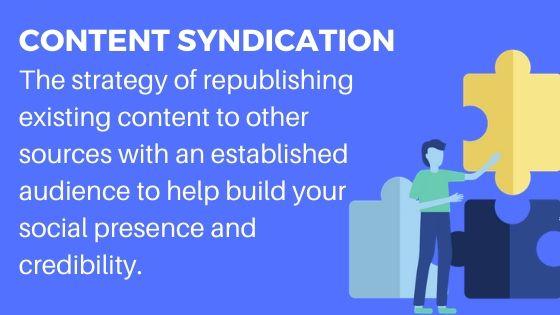
Content Syndication
Brand awareness is also brand recognition. Brand recognition is the extent of how the public can identify your brand by its attributes.
For people to recognize your brand, it’s not enough that you publish content and just leave it there hopes and wishes.
You have to make the content appear elsewhere for more exposure. This technique is otherwise known as content syndication.
How Content Syndication Impacts Brand Awareness
Content syndication is a technique involving republishing content on other sites to get a wider audience.
Syndicated content is a great way to build brand awareness as well as drive links to your website.
This is especially true if you get featured in most of the biggest and most influential sites on the Internet.
You may have heard that duplicate content from syndication can hurt your SEO and potentially penalize your website.
Technically this is true but not something I’d stress about as long as you complete these three things.
- Use Googe Search Console to make sure your content is indexed and recognized by Google before syndication.
- Share your content across your branded social media accounts and profiles.
- Add the rel canonical tag to tell search engines that your page URL is the master copy that you want to appear in SERPs.
Brand Awareness Example Using Content Syndication
BestSelf Co is known in its industry for its productivity articles. To put that in numbers, they get 186,000 new visitors every single month.
But how did they do that? By combining fantastic content marketing and blog posts with content syndication.
They targeted big sites like Inc to turn its visitors into BestSelf blog readers.
And they did successfully, driving over 1,800 email signups to their newsletter after a few weeks.
They now leverage the new traffic from syndicated content into over $2 million in revenue.
How to Boost Brand Awareness with Content Syndication
Since it is hard to land syndicated content on publishing giants like CNN, BBC, and the New York Times, you can start small through self-service syndication.
In self-service syndication, you republish your content on publishing websites such as the ones below:
Social networks
Social platforms such as LinkedIn and Quora feature their built-in publishing tools. LinkedIn publishing is mainly a great avenue as it notifies your connections every time you post an article.
Blogging platforms
You may also consider republishing on other blogging platforms aside from your own. Examples of this are Medium and Tumblr.
Medium is an excellent choice for self-service syndication because of its handy import tool that lets you import your content from anywhere on the web.
It also has its own loyal followings, enabling you to reach a new audience and engage with them.
Multi-author blogs
Multi-author blogs like Business 2 Community and Social Media Today, amongst many others, also provide a syndication-friendly platform for business-related content and digital marketing content, respectively.
Measuring Brand Awareness
In the previous section, we defined brand awareness as a measure of how well your target audience recognizes your brand. But the big question is: “how do we exactly measure brand awareness?”
In digital marketing, having a KPI is vital to determine how your strategy is performing.
KPI allows you to see what works for your brand and what doesn’t. Thus, it’s important to identify some key metrics you’ll need to measure the success of your digital marketing strategies.
Below, we’ll guide you on how to measure brand awareness with key metrics.
5 Key Metrics to Measure Brand Awareness
1.Traffic
Website traffic is a good indicator of people becoming more aware of your brand. If you are getting increased traffic to your website, this could mean that your brand awareness marketing efforts are paying off.
But when we say traffic, we mean specifically measuring direct traffic and net-new traffic to your site. Direct traffic means people directly typing your URL into the search bar.
Net-new traffic is the number of new visitors to your website given a certain period. Both of these traffic channels indicate changes in brand awareness.
You can find your direct and net-new traffic in Google Analytics.
2. Branded search
When people type the name of your brand in search engines like Google instead of typing the URL directly, that’s counted as branded search.
People won’t be searching for your brand if they are not aware of it, won’t they?
As a rule of thumb, the more people who are searching for your brand name, products, or services, the more they are aware of you.
Tracking your branded search volume lets you see how general awareness of your brand is changing.
Fortunately, Google offers plenty of tools to monitor branded search volume. You can use Google Analytics, Google Ads, or Google Trends for this matter.
3. Brand mentions
Mention is the number of times your brand, products, or services has been mentioned online.
Mention can either be on social media, in the news, or your industry publication.
Monitoring these mentions lets you know if people are talking about you and how they think about your brand.
Are they saying positive, negative, or neutral things about you? Whatever the case, you can do this to gain vital information for future products, support, and digital marketing campaigns.
To track mentions of your brand, use various tools like Google Alerts or Mention.
4. Social reach
Social reach is an engagement metric that shows how your post impacts people. If your post is shared far and wide, it is usually an indication that your content is resonating with your audience.
This metric is measured by the number of people who share your posts for their networks to see.
The more people sharing your posts, the wider your social reach becomes. And what does it mean for your business?
More people will see your content, thus creating brand awareness.
You can use tools like SharedCount to check how many times your posts get shared socially.
5. Feedback
Feedback comes in the form of surveys and reviews. This is if you want to understand how people see your brand and how you can improve it.
Surveys are great to know how people hear about your business. You can either ask existing customers how they knew about you or ask a set of an audience if they are familiar with your brand, via online or offline means.
Likewise, reviews give you insight into how actual customers perceive your brand.
Reviews significantly impact how potential customers see you, so it is crucial to monitor review sites like Yelp to know how you can improve your products or services—thus improving the people’s perception of you.
Wrapping It Up
Deciding on your brand awareness marketing strategy to connect with your target audience is the first step to creating a business that converts.
But creating awareness about your brand doesn’t happen overnight. It takes a carefully crafted strategy from your marketing team to find success.
If done right, the techniques above, combined with consistent monitoring and some great digital marketing tools, can help you build familiarity around your brand and lead to increase growth, revenue and create brand advocates.


